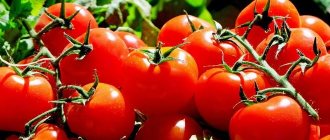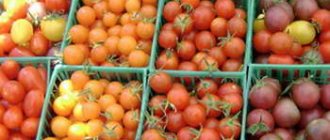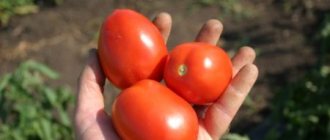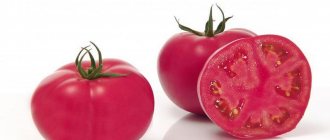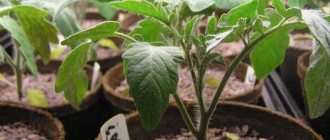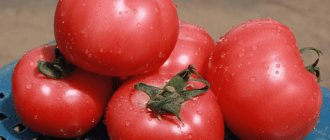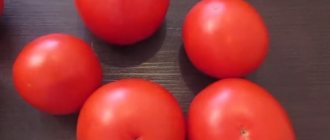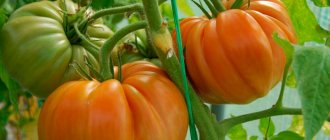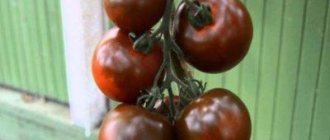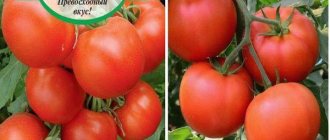The Alesi F1 hybrid is included in the State Register of Agricultural Achievements and is recommended for open ground and growing in greenhouses. This is a wonderful tomato for growing in short summer conditions.
| Height | Landing location | Ripening time | Fruit color | Fruit size | Origin | Fruit shape |
| Tall | Greenhouse, Open ground | Early ripening | Reds | Average | Hybrid | Round |
Description of Alesi tomato
The f1 hybrid is the work of French breeders from the Vilmorin company. Despite the peculiarities of the Western climate, the tomato successfully takes root on the territory of the Russian Federation. Recommended for cultivation in open ground and greenhouse conditions.
Distinctive features
Indeterminate type, without growth limitation reaches 2 meters or more. The stem is strong, the foliage is moderate, the leaves are dark green in color. The inflorescences are simple, the first fruiting branch is formed above 6-7 leaves. Each cluster bears 6–8 fruits.
An early ripening variety for spring and autumn rotation. When planted in March, fruiting ends at the end of July. With this growing method, it is possible to obtain a second (late) autumn harvest.
Productivity is high: up to 8 kg of fruits are harvested from 1 seedling. Fruiting is affected by the formation of the bush.
The hybrid is resistant to diseases of the nightshade family, for example: late blight, tobacco mosaic virus, verticillium and fusarium leaf wilt.
The high growth of seedlings requires mandatory staking and pinching.
Fruit characteristics
Average weight - 150–200 g, flat-round shape, rich pink-red color. The taste is excellent, sweet, with a characteristic sourness. The pulp is dense, juicy, there are few seeds. The peel is thick, but not hard and does not crack.
Ripe vegetables can be stored for several months and can withstand transportation over any distance, perfectly maintaining their presentation.
Universal use in cooking. Tomatoes are consumed fresh, added to various winter preparations and processed for the preparation of juices, ketchups, lecho, adjika, pasta.
The photo shows Alesi tomatoes.
Agrotechnics of cultivation, planting and care
Before planting seedlings, in order to obtain a good root system, it is recommended to water with double the rate of phosphorus fertilizers, and if necessary, such watering can be repeated two weeks after planting the seedlings, especially if it is not possible to provide the required substrate temperature.
Formation . To obtain an earlier harvest and large fruits (up to 300 grams or more), it is recommended to form the plant into one stem. A higher yield of marketable fruits weighing 180-250 grams can be obtained by forming the plant into two stems (7-8 clusters).
Due to good fruit set at elevated temperatures, it is recommended to use ALESI F1 for cultivation in the second rotation.
Fertilizer . At least a month before planting seedlings, you must make sure that the soil acidity is at the required Ph level (5.8-6.5). For starting doses and when there is a shortage of nutrients, it is recommended to use complex chlorine-free fertilizers.
ALESI F1 forms very large, fleshy fruits, therefore, in the phase when the third cluster is formed, it is recommended to fertilize with magnesium sulfate in the amount of 200-300 g/1000 l, and in the phase of setting 4-5 clusters - foliar fertilizing with magnesium sulfate and iron chelate.
During mass harvesting and at high temperatures, for better coloring of the fruits, it is recommended to increase the rate of potassium fertilizers.
Cleaning . Fruit harvesting begins (both in greenhouses and in greenhouses) must begin at medium color intensity, thus we get an early harvest and at the same time unload the plants. This harvesting method also avoids loss of marketability due to possible cracking of tomatoes in the event of uneven watering or rainfall.
The Alesi F1 tomato is included in the State Register of the Russian Federation for cultivation in open ground in private household plots. Included in the State Register as a red-fruited hybrid.
Originator : Vilmorin.
If you grew Alesi F1 tomatoes, please write what the yield and taste of the fruit were in your climatic conditions. If possible, attach a photo of these tomatoes.
Your reviews of the Alesi tomato and additions to the description will help many tomato lovers evaluate this hybrid more objectively and decide whether it is worth growing or not.
If you want to get an early harvest of tomatoes, be sure to check out the Alesi variety. The originators promise that it will provide stable yields even in the most extreme conditions. In 2008, the variety was included in the State Register of Breeding Achievements of Russia. The applicant and originator is the French seed company Vilmorin SA. Admission has been obtained in all regions of Russia. The uniqueness of this tomato is that it is recommended for open ground private farms. In protected soil, the variety can be used in spring and autumn rotations, thanks to the early and vigorous ripening of the crop. The culture is a hybrid, therefore it is labeled F1.
Read also: Infusion of strawberry leaves
How to grow seedlings
Like any other tomato crop, this hybrid is grown in the Russian climate through seedlings. You won’t be able to prepare the seeds yourself, so you will have to buy them for each planting.
Reference ! Hybrid crops do not inherit genetic traits into the next generation.
Preparing seeds, containers and soil
Purchased seed material does not require disinfection, since the manufacturer carries out the necessary preparation himself. To increase the percentage of germination, the grains are soaked in a growth stimulator for 10 hours. For this, they use not only specialized means (“Epin”, “Zircon”), but also folk methods. These methods include:
- melt water - obtained from melted snow or ice and heated to room temperature. The seed material is kept for 10 hours;
- potato juice - the vegetable is frozen, then completely thawed, finely chopped and passed through a garlic press. The seeds are placed in this juice for 9-10 hours;
- honey solution - 1 teaspoon of honey is dissolved in a glass of warm water. The seeds are kept in the solution for 5-6 hours.
Reference ! Potato juice is rich in biologically active substances, and the honey solution serves as an additional disinfectant.
Any container for planting is suitable: a common wooden box or individual plastic cups and peat pots. Planting containers must be treated with a dark-colored manganese solution to destroy pathogenic spores. Then small drainage holes are made at the bottom of each container to drain excess moisture.
The hybrid is demanding of the soil, namely its acidity . At the initial stage, slightly acidic or neutral soil is suitable. Therefore, the best option for planting is soil purchased from a specialized store. The further development of seedlings and fruiting depend on the soil composition.
Reference ! Litmus paper will help determine the acidity of the soil. A little earth is dissolved in a glass of water, and an indicator is lowered into the resulting mixture. Red color indicates high acidity (pH less than 4.0). A yellow color indicates weak values (pH 5.5–6.5), and in neutral soil the indicator will show a weak green color (pH 6.5–7.5).
The optimal acidity levels for tomato cultivation are pH 5.5–6.5.
Sowing
The prepared soil is laid out in containers and the seeds are buried 1.5 cm. Sprinkle the soil on top, lightly moisten with warm, settled water from a spray bottle and cover with film. By creating a greenhouse effect, the seeds will sprout faster. The containers are left in a warm room at a temperature of +24 °C.
Seedling care
When seedlings appear, the containers are placed on the windowsill. Daylight hours for seedlings should be at least 13 hours. If there is insufficient sunlight, the seedlings will lag behind in development, so in this case it is worth taking care of additional lighting.
Water the crop with moderately warm, settled water from a shallow watering can. There is no need to over-water the seedlings: young roots may rot. In addition, excess fluid provokes the development of fungal diseases.
After watering, the soil is loosened superficially without causing harm to the root system. This procedure improves the breathability of the soil.
When 2 true leaves appear, the seedlings are picked and placed in separate cups. In a common container, the distance between seedlings is increased to 15 cm. During picking, only strong and healthy plants that are able to survive and bear fruit in open ground are left.
2 weeks before transplantation, young bushes are hardened off by taking them out into the open air during the daytime. You need to choose a windless day, without drafts. The duration of stay on the street is at first no more than 1 hour, then up to 10 hours.
Technical data of the variety
The Alesi tomato has the following characteristics and description:
- From the moment of development of the first shoots to the receipt of full-fledged fruits, 95-105 days pass.
- The height of the bushes reaches 150-160 cm with an average size of internodes. An average number of green leaves appear on the bushes. They are slightly pointed at the ends.
- If Alesi F1 is grown in greenhouse complexes, then you can get 2 harvests per year. At the same time, the tomatoes sprout together, which allows you to quickly harvest the fruits with minimal losses.
- The inflorescences of the plant are simple, collected in brushes (from 7 to 8 pieces in each).
- The fruits look like a sphere with ribs. Their mass ranges from 0.16 to 0.19 kg. There are reviews from gardeners who, in order to increase the weight of the berries, form bushes with one stem. Then it is possible to obtain fruits weighing from 0.25 to 0.3 kg.
- Ripe red berries. The Alesi variety does not have spots or other inclusions near the stalk.
- The tomato pulp is fleshy. Moreover, it contains from 3 to 4 seed chambers.
The yield of this variety ranges from 7 to 9 kg of fruit per 1 m² of bed. Farmers indicate that Alesi is resistant to many tomato diseases. But there are also some disadvantages:
- due to the large height of the bushes, they must be tied to strong supports;
- Plants are formed into 2-3 stems.
In Russia, this variety can grow in the open ground of the southern regions. In the vast expanses of the middle zone and Siberia, it is recommended to grow Alesi in greenhouse blocks.
How to grow tomatoes
Before planting seedlings in the ground, you should take care of the composition of the soil. The soil for tomatoes should not only be nutritious and fertile, but also not exceed the permissible acidity. As mentioned earlier, this indicator is checked using litmus paper.
Reference ! Plants growing on the site will help determine acidity no worse than a specialized indicator. Sedge, sorrel and cornflower love acidic soil; clover, burdock and coltsfoot take root in slightly acidic soil, and nettle and quinoa occupy fertile soil.
Landing
A complex of mineral fertilizers is added to the soil, dug up and holes made no more than 20 cm deep.
By the time of transplanting into the ground, the first flower cluster is formed on the bushes. This is an indicator of the readiness of seedlings for planting in a permanent place.
Choose a cloudy day for planting or replant in the evening to protect the bushes from sunlight. Planted in holes together with a lump of earth, compacted and watered with warm, settled water. Then the seedlings are left to adapt to the new location.
Per 1 m2 no more than 3 plants are placed in a checkerboard pattern. This method of planting allows everyone to receive the necessary amount of light.
Further care
Tomatoes are not demanding when it comes to watering. Moisten the soil moderately, without flooding, as the top layer of soil dries out. After watering, the soil is loosened for better oxygen penetration. To keep the beds moist longer, they are mulched with straw or sawdust. Mulch also serves as a barrier to pests from entering the beds.
The best irrigation option is drip irrigation. To do this, place a plastic bottle without a bottom in the root zone and fill it with water. The liquid gradually penetrates the soil, evenly nourishing the roots. With this method of irrigation, the humidity level in the beds will always be within normal limits.
Feed the plant at least 3 times throughout the entire season. The fertilizer is a complete complex of minerals. During the flowering period, fertilizing containing phosphorus is important, and at the time of fruiting, potassium substances are added.
To strengthen the roots, 10 days after transplantation, the seedlings are watered with double the rate of phosphorus fertilizers. If necessary, the procedure is repeated after 2 weeks.
Features of care and possible difficulties
Formation should be given special attention, since this indicator affects the fruiting of the crop. When a bush is formed with 1 stem, the harvest will be early, and the fruits will be large, at least 300 g. When grown with 2 stems, the fruits will be smaller, no more than 250 g, but there will be much more ovaries compared to the first option. When breeding a hybrid for sale, the bush is grown in 2 stems.
Plants are planted regularly to prevent the plantings from becoming too crowded. In addition, the development of unnecessary side shoots takes away many useful substances necessary for the formation of fruits.
When transplanting, a wooden or metal support is installed next to each bush to secure the stem and fruit-bearing branches . If the plant is not secured, the stem may fail. Fruitful branches will begin to spread along the ground under the weight, and the fruits may rot if they come into contact with wet beds.
Diseases and pests
Despite its high resistance to diseases, the hybrid needs preventive measures. Moreover, as a rule, many other crops grow on the plots that can spread infections.
To prevent the development of diseases, before planting, tomato beds are watered with copper sulfate, which destroys fungal spores. The plants themselves are sprayed with non-toxic biological agents, for example: “Fitosporin”, “Gamair” or “Phytocid”.
Reference ! "Fitosporin" is used not only for preventive purposes - it is used to combat many fungal infections (late blight, root rot, Alternaria and Fusarium). In addition, the product strengthens plant immunity.
Good preventive measures include loosening, hilling and mulching the beds. Moderate watering with controlled humidity levels prevents the development of bacteria.
A greenhouse pest, the spider mite, is dangerous because it is not always noticed in time. Since it spreads too quickly, a large number of plantings are affected. Therefore, closed structures are ventilated daily without creating a draft.
The Colorado potato beetle is collected by hand, carefully inspecting each seedling from all sides. When there is a large concentration of insects, use the insecticide "Prestige".
A soap solution (1 piece of laundry soap per bucket of water), which is used to treat plant stems, protects against aphids. Spraying with an infusion of onion peels or nettles helps against many pests. To do this, add 2 liters of hot water to 1 liter of onion peel, and leave the mixture for 2 days.
Agricultural technology
It is recommended to grow the variety in seedlings. It is easy to calculate the time for sowing seeds yourself, taking into account the climatic conditions of the region. Seedlings are ready for transplantation at the age of 45 - 55 days. Before planting, in order to help the seedlings grow a powerful root system, they are watered with phosphorus fertilizers, increasing the rate by 2 times. The same is done 2 weeks after transplantation, especially if it is not possible to maintain the required soil temperature. The required soil pH level is 5.8 - 6.5. Plants must be tied up. To obtain an earlier harvest and large tomatoes (300 grams or more), the bush is formed into 1 stem, leaving no more than 6 inflorescences. To increase the yield, leave 2 stems and about 7 - 8 inflorescences, but the weight of the fruit will be about 180 - 200 grams. Our hero needs proper feeding; it is recommended to do it at least 3 times per season.
Read also: How does a Makita hammer drill work?
The Alesi hybrid will delight you with its high yield even in unfavorable conditions. Tomatoes of high commercial quality are distinguished by good coloring of the pulp and excellent taste. The culture is resistant to most diseases. But the variety also has disadvantages. They lie in agricultural technology - the plant needs support, formation, proper watering and timely application of fertilizers. In addition, seeds will have to be purchased annually.
Early ripening hybrids will be an excellent option for gardeners who want to harvest at the very beginning of summer. They will certainly be interested in the tomato hybrid “Alesi”, which guarantees a good harvest of tasty, juicy and healthy fruits.
10 mistakes when growing tomatoes:
Growing in open ground and greenhouse
If you pinch the top of the seedling after the formation of the 6th fruitful branch, then the plant will spend all its energy on the formation of existing ovaries, and not on further growth. This technique is used if the crop is grown for a short period, that is, when the harvest is expected to be completed before the end of July.
If the crop is grown throughout the season, then 7-8 fruitful branches are left. This will significantly increase the fruiting time, but the tomatoes will be smaller.
In case of increased acidity, it is necessary to add dolomite flour or slaked lime to the soil. Otherwise, the hybrid will not survive in an acidic environment.
Tomatoes should be planted in those beds where cabbage, celery, onions or legumes previously grew . After these crops, the soil is saturated with nitrogen, necessary for the full development of any nightshade. According to the rules of crop rotation, it is not recommended to plant a tomato twice in the same place: as the vegetable grows, it draws all the nutrients from the soil and the soil is severely depleted after it.
Harvesting and application
When breeding a hybrid for sale, vegetables are harvested in a state of milky ripeness. Unripe tomatoes last longer and withstand transportation well. They are able to ripen on their own without losing their taste. In addition, an unloaded bush ensures faster ripening of other fruits.
For personal use, tomatoes are allowed to ripen completely, using them in the preparation of various dishes, cuts and freshly squeezed juices. Tomatoes look great in whole-fruit canning and do not lose their taste in pickles and marinades. They are processed into tomato products, making juices, adjika, pastes and sauces.
Characteristics
- This hybrid is valued for its early harvest. You can start collecting 95 - 105 days from the moment of germination. The tomatoes ripen very smoothly;
- according to the State Register, the yield of marketable fruits under film cover is 7.5 - 9.5 kg per 1 square meter;
- The immunity of the variety is quite high. The plant is resistant to tomato mosaic virus, verticillium blight, brown spot and late blight. The State Register confirms resistance to Fusarium wilt;
- the fruits have high commercial quality, they are not subject to cracking and the formation of microcracks. True, the originators themselves admit that this problem still cannot be avoided due to uneven soil moisture;
- A characteristic feature of our hero is resistance to physiological disorders - uneven maturation and coloring. No matter what conditions the tomatoes are ripened in, they will not have green shoulders;
- good adaptive qualities of the hybrid are noted. It is resistant to temperature changes, even in extreme heat it does not shed flowers and ovaries;
- transportability at a high level. The presentation of Alesi fruits does not suffer from long-term transportation. Keeping quality is excellent;
- method of use is universal. The early harvest is good in its natural form; tomatoes are used in salads and used for cutting and decorating dishes. The fruits are suitable for processing into juices, lecho, pastes.
Advantages and disadvantages
Among the positive qualities of culture are:
- possibility of double circulation;
- high fruiting rate;
- disease resistance;
- simple agricultural technology;
- survival in any climate;
- drought resistance;
- excellent taste of fruits;
- uniform ripening;
- long shelf life;
- versatility in application;
- safety during long-term transportation.
The main disadvantage of the hybrid is its dependence on the composition of the soil. This also includes the mandatory formation, pinching and staking of plants.
Farmer reviews
Gardeners quickly appreciated the crop for its maximum output and the ability to harvest excellent fruits twice:
Mikhail, Moscow: “Very good hybrid for sale. Vegetables ripen quickly, are stored for a long time, and can be transported far. Since immunity is stable, you don’t have to worry about various diseases and negative natural factors.”
Vera, Volgograd: “I’ve been planting the hybrid for several years. The taste is excellent, keeping quality is good. The variety is resistant to diseases. The vegetables do not crack and are of excellent pink color. The only negative is that I can’t collect the seeds myself. But as long as the price is affordable, I’ll buy it.”
